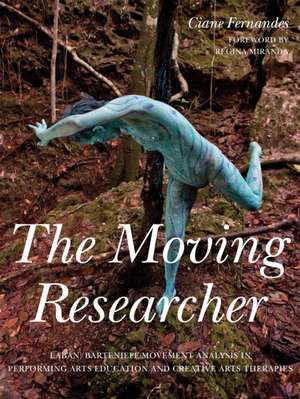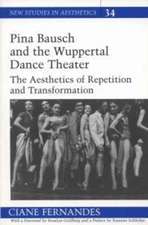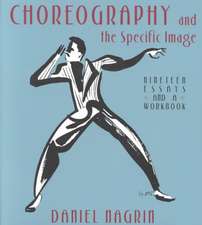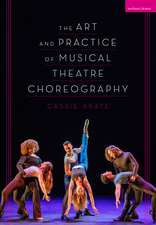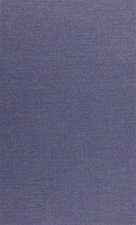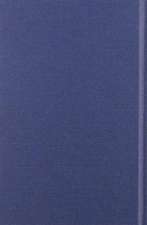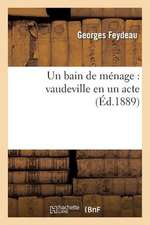The Moving Researcher
Autor Ciane Fernandesen Limba Engleză Paperback – 20 dec 2014
Preț: 256.06 lei
Preț vechi: 325.33 lei
-21% Nou
Puncte Express: 384
Preț estimativ în valută:
49.00€ • 53.21$ • 41.16£
49.00€ • 53.21$ • 41.16£
Carte disponibilă
Livrare economică 02-16 aprilie
Livrare express 18-22 martie pentru 111.60 lei
Preluare comenzi: 021 569.72.76
Specificații
ISBN-13: 9781849055871
ISBN-10: 1849055874
Pagini: 312
Ilustrații: b&w photos and drawings
Dimensiuni: 188 x 244 x 20 mm
Greutate: 0.62 kg
Editura: JESSICA KINGSLEY PUBLISHERS
ISBN-10: 1849055874
Pagini: 312
Ilustrații: b&w photos and drawings
Dimensiuni: 188 x 244 x 20 mm
Greutate: 0.62 kg
Editura: JESSICA KINGSLEY PUBLISHERS
Notă biografică
Ciane Fernandes is tenured professor at the School of Theater and the Performing Arts Graduate program at Federal University of Bahia (PPGAC/UFBA), Salvador, Brazil. She is an associate researcher at the Laban/Bartenieff Institute of Movement Studies (LIMS), New York. She has a Ph.D. in art and humanities for performing artists from New York University, a certificate of movement analysis from LIMS and a post-doctorate degree in Contemporary Culture and Communications from UFBA. For the last twenty years Ciane has worked with Laban/Bartenieff Movement Analysis and Authentic Movement in education, research and performance. She has taught and performed based on these methods internationally, and presented lecture demonstrations and photo/video exhibitions. Ciane lives in Lencois BA, Brazil. For more information, go to www.cianefernandes.pro.br or www.ppgac.tea.ufba.br.
Cuprins
Foreword. Regina Miranda. Preface to the English edition. 1. The Development of Rudolf Von Laban's Movement Theories. 1.1 The process of movement: An expanded outline of the application of Laban theory to movement. Jackie Hand, Laban/Bartenieff Institute of Movement Studies, USA. 1.2. Voicing the practice: Laban's embodied immigration to Brazil. Melina Scialom. 1.3. Choreology and Choreological Studies. Júlio Mota, Pontifical Catholic University of Paraná. 1.4 How to move things and words: Laban's Moving Analysis as Somatic-Performative Research. 1.5. Autistic or Artistic? Laban's theories applied to child disability as somatic performative integration. 2. Laban/Bartenieff Movement Analysis: Interartistic Practice, Creativity, and Dynamic Writing. 2.1. Dance theater and Laban/Bartenieff Movement Analysis. 2.2. Infinite dance: Dynamic bodies and concepts. 2.3. Laban/Bartenieff Movement Analysis and Labanotation. 2.4. The 'Mastery of Movement': The categories of Body-Effort-Shape-Space. 2.5. The dialogue among the arts in total body expression. 3. Among Rocks, Reptiles and Connective Wind Currents: The Body. 3.1. Bartenieff Principles. 3.1.1. Breath Support and Kinetic Chains. 3.1.2. Core Support. 3.1.3. Dynamic Alignment. 3.1.4. Body Organizations and Developmental Movement Patterns. 3.1.5. Bony Connections. 3.1.6. Weight Shift for Locomotion. 3.1.7. Initiation and Sequencing. 3.1.8. Gradated Rotation. 3.1.9. Effort Life for Body Connectivity. 3.1.10. Spatial Intent. 3.2. Bartenieff Fundamentals. 3.2.1. Preparatory Exercises. 3.2.2. The Basic Six. 3.3. Posture/Gesture Merger. 3.4. Gesture and Posture according to Laban and Lamb. Júlio Mota. 3.4.1. The Legacy of Rudolf von Laban. 3.5. Other Concepts and Symbols of Body. 3.5.1. Body Parts. 3.5.2. Upper and Lower Limbs. 3.5.3. Bodily Actions. 4. Effort or Eukinetics: Pitches and Colors of a Poetic Body. 4.1. The Flow Factor. 4.1.1. Free flow. 4.1.2. Bound flow. 4.2. The space factor. 4.2.1. Indirect space. 4.2.2. Direct space. 4.3. The weight factor. 4.3.1. Light weight. 4.3.2. Strong weight. 4.4. The time factor. 4.2.1. Sustained time. 4.2.2. Quick time. 4.5. The Effort Factors and Quaternary Correspondences. 4.6. Pre-Effort. 4.6.1. Space Pre-Effort. 4.6.2. Weight Pre-Effort. 4.6.3. Time Pre-Effort. 4.7. The Combination of Factors. 4.7.1. Effort States. 4.7.2. Effort Drives. 4.8. Effort Phrases and Phrasing. 4.8.1. Effort Phrases. 4.8.2. Effort Phrasing. 5. Putting the Body Relationships in Shape. 5.1. Shape Flow. 5.1.1. Growing/opening/unfolding. 5.1.2. Shrinking/closing/folding. 5.1.3. Growing and Shrinking Alternately. 5.2. Spoke-Like and Arc-Like Directional. 5.3. Shaping. 5.4. Specific Shapes Created by the Body. 5.5. Relationships. 6. The Architecture of Moving Spaces. 6.1. Space Harmony. Susanne Schlicher, Professor/Dramaturg, Theaterakademie Hamburg/Hochschule für Musik und Theater (Hamburg University of Music and Theatre. 6.1.1. Space Harmony and Bartenieff Fundamentals. 6.2. Kinesphere. 6.3. Reach Space. 6.3.1. Small Kinesphere- Near Reach. 6.3.2. Medium Kinesphere- Mid Reach. 6.3.3. Large Kinesphere- Far Reach. 6.4. Crosses of Axes. 6.4.1. Standard Cross of Axes. 6.4.2. Body Cross of Axes. 6.4.3. Constant Cross of Axes. 6.5. Crystalline Forms. 6.5.1. The Tetrahedron. 6.5.2. The Octahedron and its Three Dimensions. 6.5.3. The Cube and its Four Diagonals. 6.5.4. The Icosahedron and its Three Planes. 6.5.5. The Dodecahedron and its Three Planes. 6.6. Spatial Pathway. 6.6.1. Central Pathway. 6.6.2. Transverse Pathway. 6.6.3. Peripheral Pathway. 6.7. Spatial Tension. 6.7.1. Central Tension. 6.7.2. Transverse Tension. 6.7.3. Peripheral Tension. 6.8. Other concepts and symbols of Space. 7. Associating Body-Effort-Shape-Space. 7.1. Choreutics: Tuning and turning compositions. 7.1.1. Affinities in the Octahedron Dimensions. 7.1.2. Affinities in the Cube Diagonals. 7.1.3. Affinities in the Isocahedron Planes. 7.1.4. From points in Space to movement composition: The Personal Scale. 7.1.5. From Shape Flow to movement composition: Authentic Movement. 7.2. Body Attitude. 7.2.1. Body. 7.2.2. Effort Stress. 7.2.3. Shape Stress. 7.2.4. Space Stress. 7.3. Themes of Continuous Dynamics and Change. 7.3.1. Inner/Outer. 7.3.2. Exertion/Recuperation. 7.3.3. Function/Expression. 7.3.4. Mobility/Stability. 8. Mapping Bodily Histories: Drawing the Moving Body-Text. 8.1. The observation of human movement for description. 8.2. The description of human movement. 8.2.1. The Effort-Shape Horizontal Motif. 8.2.2. The Discursive Description and the Vertical Motif Description. 8.2.3. The Detailed Description. 8.3. Simplified Movement Analysis. 8.3.1. LMA Simplified Coding Sheet. 8.3.2. Filling Out the Simplified Coding Sheet- An Example. 8.3.3. Applying the Simplified Coding Sheet to dance movement analysis: Bahian urban environment and daily life in the moves of 'Hidden Agenda' by Tran Chan Dance Company. 8.4. Detailed Movement Analysis. 8.4.1. LMA Detailed Coding Sheet. 8.4.2. Filling out the Detailed Coding Sheet- An Example. 8.4.3. Applying the Detailed Coding Sheet to character movement analysis: Carmen Maura in the Pedro Almodóvar's film 'Women on the Verge of a Nervous Breakdown.' Ciane Fernandes. Susanne Schlicher. Rosel Grassmann, Artist and Director at Wilderness BodyPainting, Independent Concept and Photo Artist of Movement Studies. Works Cited.
